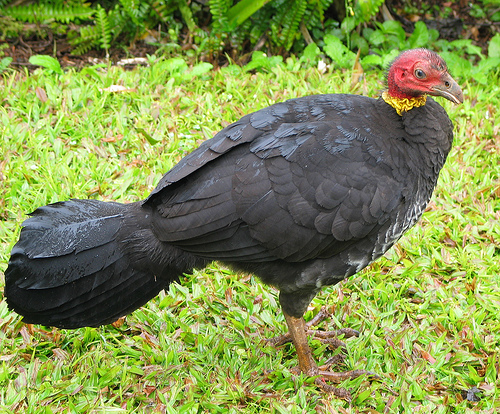This story is so kooky that I must lead with the video:
This slow-motion film stars turkeys of different ages, from hatchlings to adults, and yes, they’re furiously climbing a steep wooden ramp. The video comes from a study published earlier this month. But let me start at the beginning.
In January 2004, nine Australian brush turkeys were minding their own business in the Barossa Valley when a couple of researchers scooped them up in great big nets.
The scientists, visiting from the Flight Laboratory of the University of Montana-Missoula, wanted to find out how the birds’ locomotor performance changes as they grow up.

So every three days for the next two weeks, they weighed the birds, measured their wingspan, photographed them, and finally placed them at the bottom of a ramp — 6 inches wide, 6.5 feet long and, to maximize traction, “covered in a 30-grit sandpaper covered with rubber carpet backing and fine hardware cloth”. They set the ramp at different angles — from horizontal to 110 degrees (that’s 20 degrees past vertical) — and the turkeys ascended it as best they could. They didn’t even need a running start.
(I, too, wondered why birds would so eagerly run up a ramp. Turns out that many types of gamefoul evolved to do so in order to escape from predators and retreat to elevated roosts, as one of the Montana researchers, Kenneth Dial, first reported in Science in 2003.)
The researchers videotaped the turkeys scooting up the ramps and later categorized each attempt as either: success without slipping; slipping (occasional foot slips, but eventually getting there); treadmilling (running in place on the ramp with no forward progress); or failure (sliding backwards or giving up).
As you saw in the video, the youngest turkeys cleared the steepest slopes: 2-day-olds successfully climbed the 110 degree ramp, whereas the adults began to slip around 50 degrees.
So what gives? Well, in the wild, Australian brush turkeys are fiercely hunted when they’re young: just 15 percent survive the first three weeks. Also, young birds colonize new terrains and thus fly much more than adults do. The authors hypothesize that the youngest turkeys depend on forelimb (wing) strength, which helps them carry out these exquisite climbing feats. As they get older and larger, the turkeys develop stronger hindlimbs that allow them to out-run predators and build hefty (13,000 pounds!) nests, but make it much more difficult to scramble up trees.
All of the turkeys survived the ordeal and were eventually returned to their beloved brush.
**
Image of the Australian brush turkey courtesy of Wikimedia Commons.
Who knew that turkeys had such grit? The more I learn about them, the more I like these wiley creatures. It’s tofurkey for me.